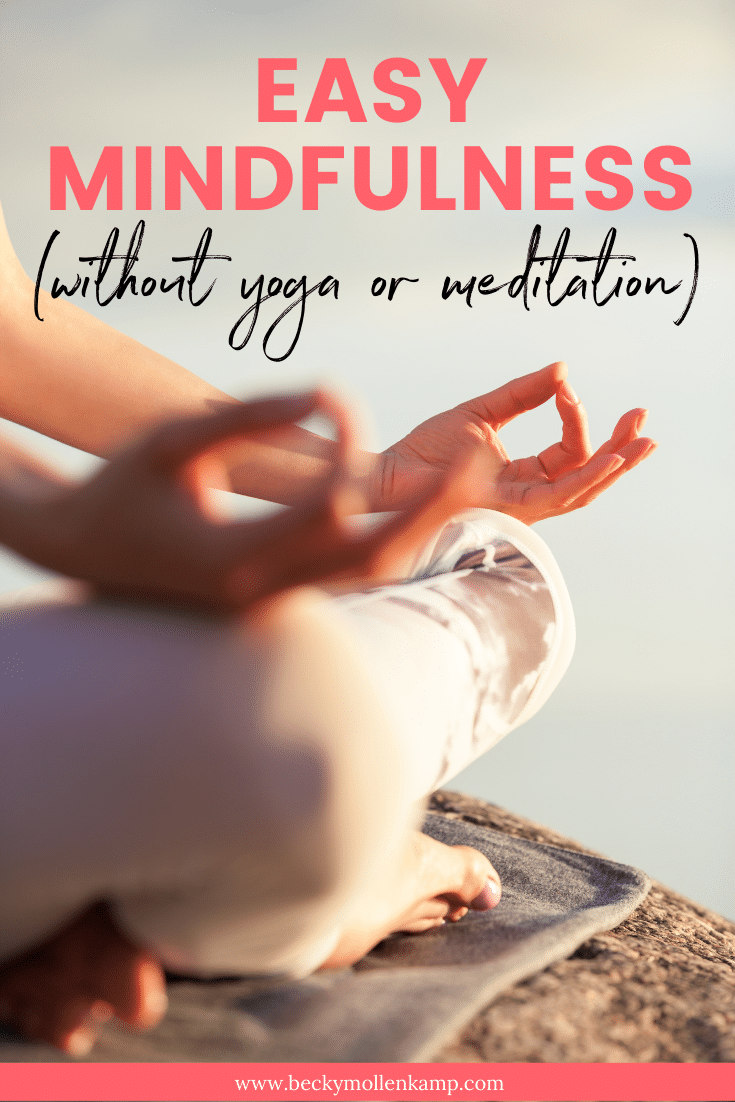Free Mindfulness Exercises for Everyday
Free Mindfulness Exercises for Everyday
By Becky Mollenkamp, PCC
A client recently asked me for some advice on how to be more mindful. She already does yoga, but wanted ideas for how to be more present throughout her days, no just when she’s on the mat.
The truth is, mindfulness serves us best when we do it every day, throughout day — and not just when we have 30 minutes or more to dedicate to meditation or yoga.
In fact, long-form mindfulness doesn’t work for everyone. It can actually create more stress to sit in silence, especially for those who are new to the concept or who deal with lots of anxiety.
In fact, I believe anyone can be mindful at any time. It can be accomplished in just a few seconds!
Mindfulness simply means being aware and fully present in the current moment. It’s about bringing your focus—even if only for a few fleeting seconds—to the present (vs. living in the future or past).
This practice is so powerful because it helps reduce stress and worry, which are results of living in the past or future. And science has proven that less stress and worry bring about many mental and physical health benefits.
Being mindful needn’t be a monumental task…but it does require intention. So, here are three ideas for how to be more mindful at any time, every single day.
1. Breath Work
This sounds simple—and it is. Even so, most of us rarely bring conscious awareness to our breath. We take it for granted, simply allowing it to pass without notice.
When you notice yourself being pulled out of the present moment, focusing on your breath can be powerful. Bring awareness to the breath, then take a deep, intentional breath.
Continue doing slow breathing (perhaps while counting—4 seconds inhale, 8 seconds exhale) until you feel the anxiety lessen or the tension lighten. Even if that’s not yet possible, use focused breath work to return your thoughts to the present moment.
2. The 5 Senses
Another way to become more mindful is to conduct a quick scan of your five senses—sight, sound, smell, taste, and feel. Cataloging what is happening in the moment with each sense gives your brain a present-focused task to pull it out of the past or future.
Bring total awareness to each sense, one at a time. Notice everything you smell until you can’t smell anything new. Do the same for what you hear, taste, feel, and see.
You can spend just a few seconds on each sense, or you can stretch it out for a longer mindfulness moment. Savor each sense fully and turn this into a 5-, 10-, 20-minute mindfulness exercise.
3. Ask 3 Questions
When your thoughts get stuck in a loop or begin to spiral into the past or future, take a beat to ask yourself these three questions. This exercise helps you regain focus and presence.
1. What am I thinking? Rather than submitting to a general sense of anxiety, sadness, etc., examine what thoughts you’re actually having. Scan and catalog each one.
2. What am I making this mean? There are thoughts, and then there is the meaning we attach to them. You may be thinking, “I’ll never finish this project.” What you may be making that mean is, “I’m a failure.” Following your thoughts down the rabbit hole can help shed light on what’s really going on.
3. What’s my choice? You may feel out of control, but focusing on your choices can help you regain a sense of agency. Taking action can help to quiet the thoughts so you can return to the present. Even when you have no ability to change what’s happening, you can choose how you react (here is where breath work or self-care can be valuable).
Finally, create a habit around your contemplative practices. As an example, taking a deep breath each time you pick up your phone, or doing a senses scan whenever you get in the car.
This is called “trigger training,” assigning a reaction to an action. Create a trigger and then do it with intention for as long as it takes to become automatic. It could be days or weeks, but it will take root if you do it consistently and intentionally enough ties.
In my case, I immediately begin asking myself the 3 Questions whenever I turn on the shower. After being intentional about it for a few weeks, it became a habit that is now several years old.
Habits are a great way to get more mindfulness throughout the day. It’s more powerful to have a dozen 1-minute doses of mindfulness in a day than a single 12-minute dose.
Shorter but more frequent mindfulness activities returns your brain to the present more times throughout the day. There is a residual effect that goes beyond the single moment, which quickly compounds your time. Plus, doing it more often is another way to make mindfulness an automatic habit rather than a focused effort.
Recommended reading: “Power of Now” by Eckhart Tolle is an incredible book about the importance of mindfulness, as well as how to achieve it. I highly advise listening to the audiobook while going for a walk in nature—it’s a powerful way to be present!




